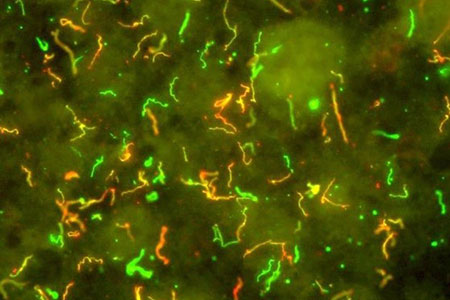
Lyme Disease Bacteria, Borrelia burgdorferi2
Well, ticks are not unlike humans. They, too, enjoy an early spring day. I had often heard that mild winters meant an explosion in the tick population, but that's not precisely true. Mild winter weather does not mean that there will be more of these blood suckers out there, just that they are active earlier in the year.
"While entomologists say that the mild weather in much of the country this winter is unlikely to spawn a tick population explosion this spring and summer, they suggest that just like humans and dogs, the pesky critters appear to be enjoying the great outdoors a month or two earlier this year," said Richard Pollack, a public health entomologist and instructor in the department of immunology and infectious diseases at the Harvard School of Public Health.
"Last year at this time, people were sitting in their living rooms watching TV, but now they're out in their neighborhoods, enjoying the warm weather with their dogs and wearing T-shirts," Dr. Pollack said.
"It's not that the warm weather has created more ticks, but it has created the opportunity for both humans and ticks to be more active and to make contact with each other"1.
Where there are ticks, there exists the opportunity for Lyme disease! Here's what you need to know to avoid Lyme disease infection.
What is Lyme Disease?
According to the NIH, "Lyme disease, or borreliosis, is caused by the spirochete bacterium Borrelia burgdorferi and is transmitted to humans through the bite of an infected blacklegged deer tick. It is the most common tickborne infectious disease in the United States"2.Lyme disease is the 7th most common reportable disease in U.S. and cases have been increasing steadily both in numbers and distribution3.
You can find out more from the CDC Website at the following links:
How Do You Know if You Have Lyme Disease?
Symptoms range from an erythema migrans rash, early in the course of infection, to neuritis, carditis, and arthritis in later, disseminated stages of illness. A subset of patients, especially those diagnosed and treated in later stages of illness, may have persistent fatigue, muscle aches, short-term memory problems, and other nonspecific symptoms3.How Do You Prevent Tick Bites?
The Center for Disease Control (CDC) has a very nice resource to help you prevent exposure to ticks and the resulting bite.Can You Treat Lyme Disease?
Yes, prompt treatment with two-to-four weeks of oral doxycycline results in symptomatic cure of the great majority of patients2. However, many patients do not realize they have been infected until late stage symptoms emerge. This has spawned one of the highest priority research needs in the field of Lyme disease; to elucidate the specific cause or causes of symptoms in these patients and to determine the safest and most effective treatment options3.Modeling Lyme Disease in Mice
Studies using animal models have provided valuable information regarding the pathogenesis and immunoprophylaxis of Lyme borreliosis. Mice (B6, C3H, Spontaneous Mutant (SCID), BALB/c) and the rhesus monkey have been the main animal models used so far, providing knowledge of the host immune response and the behavior of bacteria in these hosts. Another animal model that may prove valuable in defining a cure for treatment-resistant chronic Lyme arthritis is the HLA-DR4 (Model 4149)5."Murine (mouse) systems of severe destructive Lyme arthritis will provide a tremendous advantage in the future elucidation of immunological mechanisms that result in severe destructive Lyme arthritis," writes Munson et al in Clinical and Developmental Immunology, now the open-access Journal of Immunology Research. "In particular, the advent of a system in which immune cells from an immunocompetent host are programmed in vitro to elicit severe destructive Lyme arthritis upon subsequent transfer into a recipient immunocompetent host presents great potential in the ultimate elucidation of the mechanisms of severe destructive Lyme arthritis."
"In addition, this system may also allow for simultaneous assessment of Lyme borreliosis vaccine candidates (following selection of protective epitopes [74]) for production of protective borreliacidal antibodies in vitro [50, 75-78] as well as the deleterious capability of priming recipients for induction of severe destructive Lyme arthritis [50]. Taken together, these investigations may contribute to the production of a safe and efficacious vaccine to prevent B. burgdorferi infection"4.
Lyme disease is a serious human health hazard and we need to do all we can to prevent it. Enjoy the outdoors, but be safe out there!






.jpg)

.jpg)
.jpg)
.jpg)
.jpg)





.jpg)
.jpg)


.jpg)



.jpg)




.jpg)

.jpg)
.jpg)






